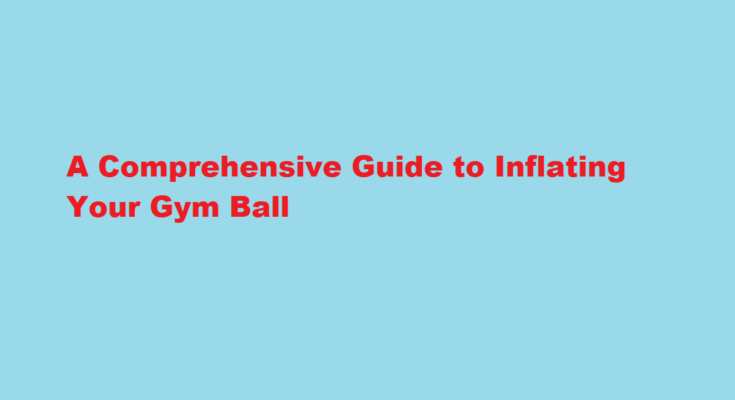Introduction
A gym ball, also known as a stability ball or exercise ball, is a versatile piece of fitness equipment that can be used for a wide range of exercises to improve balance, flexibility, and core strength. To reap the full benefits of your gym ball, it’s crucial to ensure that it’s properly inflated. In this comprehensive guide, we will walk you through the steps to inflate your gym ball correctly, ensuring safety and optimal performance during your workouts.
Why Proper Inflation Matters
Before delving into the inflation process, it’s essential to understand why proper inflation matters. An under-inflated gym ball can compromise your workout by reducing stability and potentially causing injury. On the other hand, an over-inflated ball may burst, posing a significant safety hazard. Therefore, striking the right balance in inflation is crucial for both effectiveness and safety.
Choosing the Right Gym Ball Size
Gym balls come in various sizes, typically measured in centimeters. The size you choose should be based on your height, as different sizes are designed to accommodate different height ranges. Here’s a rough guideline
1. If you are under 5 feet (152 cm) tall, choose a 45 cm gym ball.
2. If you are between 5 feet (152 cm) and 5 feet 5 inches (165 cm) tall, opt for a 55 cm gym ball.
3. If you are between 5 feet 6 inches (168 cm) and 6 feet (183 cm) tall, a 65 cm gym ball is suitable.
4. If you are over 6 feet (183 cm) tall, go for a 75 cm gym ball.
Now, let’s get into the steps for properly inflating your gym ball.
Gather the Necessary Equipment
Before you start inflating your gym ball, make sure you have the following items ready
1. Gym ball
2. Hand or foot pump with the appropriate nozzle
3. Measuring tape
4. Pressure gauge (optional but recommended)
Prepare the Gym Ball
Unpack your gym ball and lay it flat on the floor. Ensure that the ball is clean and free of any sharp objects or debris that could potentially puncture it during inflation.
Locate the Inflation Hole
Every gym ball has an inflation hole, typically located near the ball’s valve. It may be covered by a plug or cap that needs to be removed for inflation. Check your gym ball’s user manual if you’re unsure where the inflation hole is located.
Attach the Pump Nozzle
Attach the nozzle of your hand or foot pump to the inflation hole securely. Make sure it’s a snug fit to prevent air leakage during inflation.
Begin Inflating
Start pumping air into the gym ball using a controlled and steady motion. It’s essential to inflate the ball gradually to avoid over-inflation. If you’re using a pump with a pressure gauge, monitor the pressure as you go.
Measure the Diameter
As you inflate the gym ball, periodically measure its diameter using a measuring tape. Refer to the size guidelines mentioned earlier to ensure you’re inflating it to the correct size. Stop inflating once you reach the desired diameter.
Test the Firmness
Once you’ve reached the correct diameter, it’s time to assess the firmness. Sit or gently press on the gym ball with your body weight to gauge its firmness. It should have some give but remain stable. Adjust the inflation if needed to achieve the desired firmness.
Seal the Inflation Hole
After you’re satisfied with the inflation level and firmness, seal the inflation hole with the provided plug or cap. Make sure it’s securely closed to prevent any air from escaping.
Check for Leaks
To ensure the gym ball is airtight, perform a quick leak check. Apply a soapy solution (dish soap and water) to the inflation hole and gently rotate the ball to check for bubbles. If you notice any bubbles, there may be a leak, and you should address it promptly.
Frequently Asked Questions
What pressure should I use to inflate my exercise ball?
Stability/balance balls are not inflated to a specific psi (pounds per square inch). The range of inflation for all the stability balls is between 0.6 PSI and 0.9 PSI. Generally, users should inflate to their desired firmness within that range. Follow the guidelines below for inflating.
How do you measure a ball?
Put the ball on a table and close the cylinder around the ball. Mark where the paper’s (vertical) edge meets the other side of the ball while the cylinder is perpendicular to the table. This allows you to measure the circumference. Then the division by π (3.1418) gives the diameter, which is the width of the ball.
Conclusion
Properly inflating your gym ball is a critical step in ensuring both safety and effectiveness during your workouts. By following these steps and guidelines, you can enjoy the numerous benefits of using a gym ball in your fitness routine with confidence. Remember to periodically check and adjust the inflation to maintain optimal performance and safety over time.
Read Also : Mastering The Cue How to Play Pool Like a Pro



